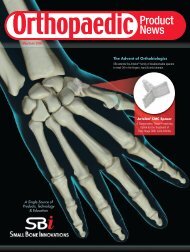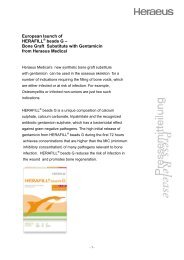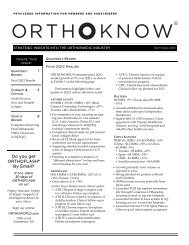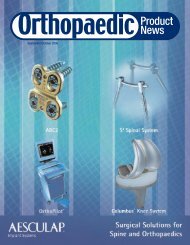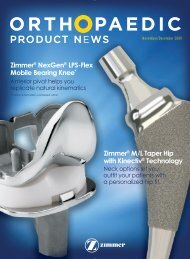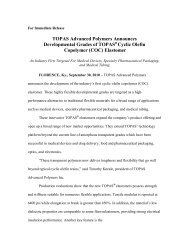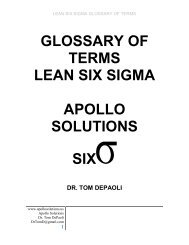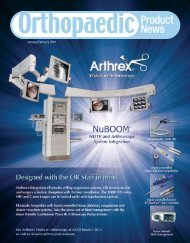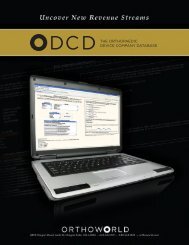Final Program - Omtec
Final Program - Omtec
Final Program - Omtec
- No tags were found...
Create successful ePaper yourself
Turn your PDF publications into a flip-book with our unique Google optimized e-Paper software.
<strong>Final</strong> <strong>Program</strong>Addresses, Educational Sessions/WorkshopsI will address these specific points:• y The price paid for an offshore purchase is not its cost.It is only one of many elements that comprise thecost of an item being purchased.• y Traditional accounting methods obscure therelationships between costs incurred to supportoffshore purchases and the items being purchased.This leads to inappropriate offshoring decisions andundermines a company’s profitability.• y A well-designed, robust cost model can providemanagement with the accurate and relevant costinformation required to make economically soundoffshoring decisions.Attendees will receive these tools to put to immediate use:• y An understanding of how the “price” of a purchaseditem does not equal its “cost” — especially when theitem is manufactured by an offshore supplier.• y A checklist of costs that must be considered if acompany is to understand the true cost of offshorepurchases.• y An outline for creating a valid and robust costmodel that will enable an organization to measurecosts related to offshoring and link them to themanufactured items being purchased.BIO: During his 25 years as a consultant, Doug Hicks haschampioned the development of practical, down-to-earth costmanagement solutions for small and mid-sized organizations.In that time he has helped nearly 200 organizations of all typesand sizes transform their history-oriented accounting data intocustomized, value-enhancing decision support informationthat provides accurate and relevant intelligence needed tothrive and grow in a competitive world. He has shared hisexperience through dozens of seminars conducted throughoutthe U.S. and in dozens of trade and professional periodicals(including Management Accounting, Cost Management,Manufacturing Engineering and Journal of Accountancy) and twobooks, including I May Be Wrong, But I Doubt It: How AccountingInformation Undermines Profitability.Doug is a 1970 graduate of the University of Michigan— Dearborn. In 1997, he was awarded the University’s“Professional Growth and Scholarship Award” for his role asa leader in advancing cost management concepts, and in 1998he was selected as the Institute of Management Accountants’“Instructor of the Year.” He is a member of the Instituteof Management Accountants, Institute of ManagementConsultants and the Michigan Association of CPAs.Workshop: FDA 510(k) 101Floyd G. Larson, MS, MBAPresident, PaxMed International, LLCThursday, June 172:00 p.m. – 3:30 p.m.While there is uncertainty about the future of the 510(k) processfor marketing clearance of medical devices, this has for the past30 years been the dominant pathway by which new medicaldevices have reached the market in the U.S. The 510(k) processhas changed over the years, and may change further, but wedo not expect that it will be abandoned by FDA. Therefore,anyone who works in the field of medical devices, whetherentrepreneur, investor, manager, engineer or regulatoryprofessional, should be familiar with how the process worksand how he or she can contribute to a successful outcome.I will address these specific points:• y History of the 510(k) process, how it has changedfrom its early days and how it fits into FDA’s overallapproval processes• y Strategies for submission and the types of 510(k)s• y The role of FDA guidance documents andinternational standards in facilitating the 510(k)process• y The place of bench testing, in vitro testing, animaltesting and clinical studies in the 510(k) processAttendees will receive these tools to put to immediate use:• y How to determine whether a 510(k), anothersubmission, or even no submission is required• y Examples of classification and guidelines forselection of predicate devices• y Structure of a 510(k) and logistics of submitting it toFDA• y How and when to respond to an FDA request foradditional information• y What to do about a Not Substantially Equivalent(NSE) letterBIO: Floyd G. Larson is a leader in biomaterials technologyand regulatory issues, with extensive experience in productdevelopment, regulatory strategy, marketing clearance andthe translation of ideas to commercial reality. His educationalbackground in chemistry, materials science and businessmanagement prepared him for a career that has includedapplied research, management of R&D, and, as Vice President,Scientific Affairs for a manufacturer of implantable medicaldevices, overall responsibility for R&D, Engineering, ClinicalResearch and New Business Development.Page 182010



